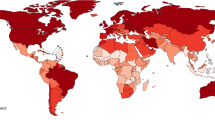Abstract
Background: Previous research has found comorbid severe mental illness and substance misuse (dual diagnosis) to be highly prevalent and to be associated with serious clinical and social problems, and increased service use in inner-city populations. The present study measures the prevalence of dual diagnosis, patterns of substance misuse, and associated in-patient use in a more demographically representative population in a suburban area of South London Method: We identified representative prevalent cases with psychotic illnesses who had been in contact with services in a geographically defined catchment area in Croydon over the previous 6 months. Cases of alcohol or substance misuse and dependence were identified through standardised interviews with patients and keyworkers, and socio- demographic and in-patient psychiatric service use data were also recorded. Results: Sixty-one of the 124 cases identified were randomly selected for interview, of whom 66% responded (N = 40). The prevalence rates of dual diagnosis (DD) observed were 33% (95% CI 18–47%) for any substance misuse, 20% (95% CI 8–32%) for alcohol misuse only, 5% (95% CI −16 to 26%) for drug misuse only, and 8% (95% CI −0.7 to 16%) for both drug and alcohol misuse. A lifetime history of any illicit drug use was observed in 35% of the sample (95% CI 20–50%). Patients who misuse alcohol and drugs were not found to be more likely to have been admitted to hospital in the previous 2 years, with little difference being observed between DD and psychosis-only patients in the mean number of in-patient admissions in this period (mean difference 0.25, 95% CI for difference −1.5 to 2.0). However, the DD patients were found to have spent on average over twice as long in hospital as other psychotic in-patients over the previous 2 years (mean difference 67.3 days, 95% CI for difference −205.9 to 71.2 days). DD patients were also found to have a greater number of unmet areas of need than the psychosis-only patients, which included accommodation, daytime activity, and social life, as well as substance misuse. Conclusions: The prevalence of substance misuse in patients with severe mental disorders in a suburban area is about as high as that for similar patients in inner-city London. While DD patients are not admitted more often than patients with psychosis alone, they have double the length of in-patient stay, which may be attributable to higher levels of unmet need.
Similar content being viewed by others
Author information
Authors and Affiliations
Additional information
Accepted: 6 April 2000
Rights and permissions
About this article
Cite this article
Wright, S., Gournay, K., Glorney, E. et al. Dual diagnosis in the suburbs: prevalence, need, and in-patient service use. Soc Psychiatry Psychiatr Epidemiol 35, 297–304 (2000). https://doi.org/10.1007/s001270050242
Issue Date:
DOI: https://doi.org/10.1007/s001270050242




